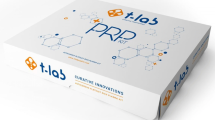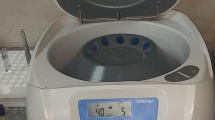Abstract
Background
Because of the poor quality of life that results from the open technique (open excision and packing) for surgically treating pilonidal cyst disease, several alternatives that accelerate the wound-healing process have been proposed. This study aimed to evaluate the effect of platelet-derived growth factors on the healing process.
Methods
Fifty-two patients with pilonidal sinus disease who underwent open excision and secondary closure of the surgical wound (n = 22) or additional local postoperative infusion of platelet-derived growth factors (n = 30) were evaluated. Duration of total wound healing and time to return to normal activities were evaluated. Quality of life of patients in each group was assessed via a stabilized questionnaire.
Results
Wound-healing rates were much greater for the platelet group (p < 0.01). Complete healing of the surgical wound required 24 days for the platelet group while the respective time for the control group was more than 30 days (p < 0.01). Patients in the platelet group returned to their normal activities around the postoperative day 17 when mean wound volume was about 10 cc, while control group patients managed to do so around the postoperative day 25.
Conclusions
These data provide evidence that the use of platelet-derived growth factors directly to the surgical wound enhances the healing process resulting in faster recovery of patients surgically treated for pilonidal sinus disease.




Similar content being viewed by others
References
Chintapatla S, Safarani N, Kumar S et al (2003) Sacrococcygeal pilonidal sinus: historical review, pathological insight and surgical options. Tech Coloproctol 7:3–8
Buie LA (1944) Jeep disease (pilonidal disease of mechanized warfare). South Med J 37:103–109
Karydakis GE (1973) New approach to the problem of pilonidal sinus. Lancet 2:1414–1415
Karydakis GE (1992) Easy and successful treatment of pilonidal sinus after explanation of its causative process. Aust N Z J Surg 62:385–389
Bascom J (1983) Pilonidal disease: long-term results of follicle removal. Dis Colon Rectum 26:800–807
Notaras MJ (1970) A review of three popular methods of treatment of postanal (pilonidal) sinus disease. Br J Surg 57:886–890
Sondenaa K, Andersen E, Nesvik I et al (1995) Patient characteristics and symptoms in chronic pilonidal sinus disease. Int J Colorectal Dis 82:752–753
Keshava A, Young CJ, Rickard MJ et al (2007) Karydakis flap repair for sacrococcygeal pilonidal sinus disease: how important is technique? ANZ J Surg 77(3):181–183
Kement M, Oncel M, Kurt N (2006) Sinus excision for the treatment of limited chronic pilonidal disease: results after a medium-term follow-up. Dis Colon Rectum 49(11):1758–1762
Monteleone K, Marx RE, Ghurani R et al (2000) Healing enhancement of skin graft donor sites with platelet-rich plasma. Presented at the 82nd Annual American Academy of Oral and Maxillofacial Surgery Meeting, San Francisco, CA, September 22
Man D, Plosker H, Winland-Brown JE (2001) The use of autologous platelet rich plasma (platelet gel) and autologous platelet-poor plasma (fibrin glue) in cosmetic surgery. Plast Reconstr Surg 107(1):229–237
Rudkin GH, Miller TA (1996) Growth factors in surgery. Plast Reconstr Surg 97:469
Leitner GC, Gruber R, Neumuller J et al (2006) Platelet content and growth factor release in platelet-rich plasma: a comparison of four different systems. Vox Sang 91(2):135–139
Tejirian T, Lee JJ, Abbas MA (2007) Is wide local excision for pilonidal disease still justified? Am Surg 73(10):1075–1078
Al-Salamah SM, Hussain MI, Mirza SM (2007) Excision with or without primary closure for pilonidal sinus disease. J Pak Med Assoc 57(8):388–391
McCallum I, King PM, Bruce J (2007) Healing by primary versus secondary intention after surgical treatment for pilonidal sinus. Cochrane Database Syst Rev 17(4):CD006213
Doll D, Krueger CM, Schrank S et al (2007) Timeline of recurrence after primary and secondary pilonidal sinus surgery. Dis Colon Rectum 50(11):1928–1934
Allen-Mersh TG (1990) Pilonidal sinus: finding the right track for treatment. Br J Surg 77:123–132
Kronborg O, Christensen K, Zimmemann-Nielsen C (1985) Chronic pilonidal disease: a randomized trial with a complete 3-year follow-up. Br J Surg 72(4):303–304
Perruchoud C, Vouilleumier H, Givel JC (2002) Pilonidal sinus: How to choose between excision and open granulation versus excision and primary closure. Study of a series of 141 patients operated on from 1991 to 1995. Swiss Surg 8(6):255–258
Wrotniak M, Bielecki T, Gaździk TS (2007) Current opinion about using the platelet-rich gel in orthopaedics and trauma surgery. Ortop Traumatol Rehabil 9(3):227–238
van den Dolder J, Mooren R, Vloon AP et al (2006) Platelet-rich plasma: quantification of growth factor levels and the effect on growth and differentiation of rat bone marrow cells. Tissue Eng 12(11):3067–3073
Kapoor M, Nomiyama T, Bruemmer D et al (2006) Growth factors and cytokines: emphasis on their role in wound healing and atherosclerosis. Curr Anaesth Crit Care 17:13–20
Nurden AT, Nurden P, Sanchez M et al (2008) Platelets and wound healing. Front Biosci 13:3532–3548
Tang YQ, Yeaman MR, Selsted ME (2002) Antimicrobial peptides from human platelets. Infect Immun 70:6524–6533
Virchenko O, Grenegard M, Aspenberg P (2006) Independent and additive stimulation of tendon repair by thrombin and platelets. Acta Orthop 77(6):960–966
Everts PA, Overdevest EP, Jakimowicz JJ et al (2007) The use of autologous platelet-leukocyte gels to enhance the healing process in surgery, a review. Surg Endosc 21(11):2063–2068
Brazier JE, Harper R, Jones NM (1992) Validating the SF-36 health survey questionnaire: new outcome measure for primary care. BMJ 18:305
McHorney CA, Ware JE, Raczek AE (1993) The MOS 36-item short-form health survey (SF-36). Psychometric and clinical tests of validity in measuring physical and mental health construct. Med Care 31(3):247–263
Author information
Authors and Affiliations
Corresponding author
Rights and permissions
About this article
Cite this article
Spyridakis, M., Christodoulidis, G., Chatzitheofilou, C. et al. The Role of the Platelet-Rich Plasma in Accelerating the Wound-Healing Process and Recovery in Patients Being Operated for Pilonidal Sinus Disease: Preliminary Results. World J Surg 33, 1764–1769 (2009). https://doi.org/10.1007/s00268-009-0046-y
Published:
Issue Date:
DOI: https://doi.org/10.1007/s00268-009-0046-y




